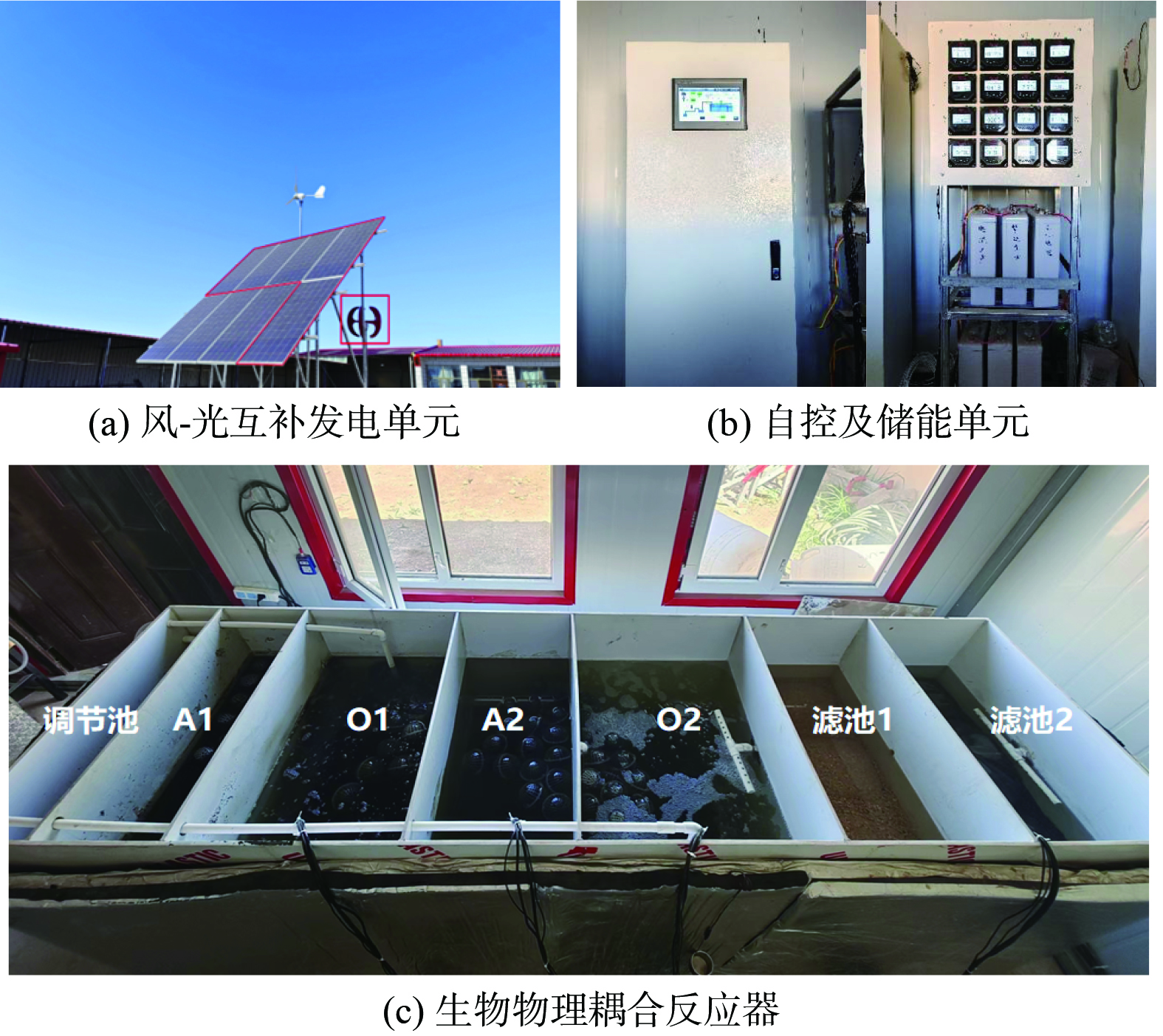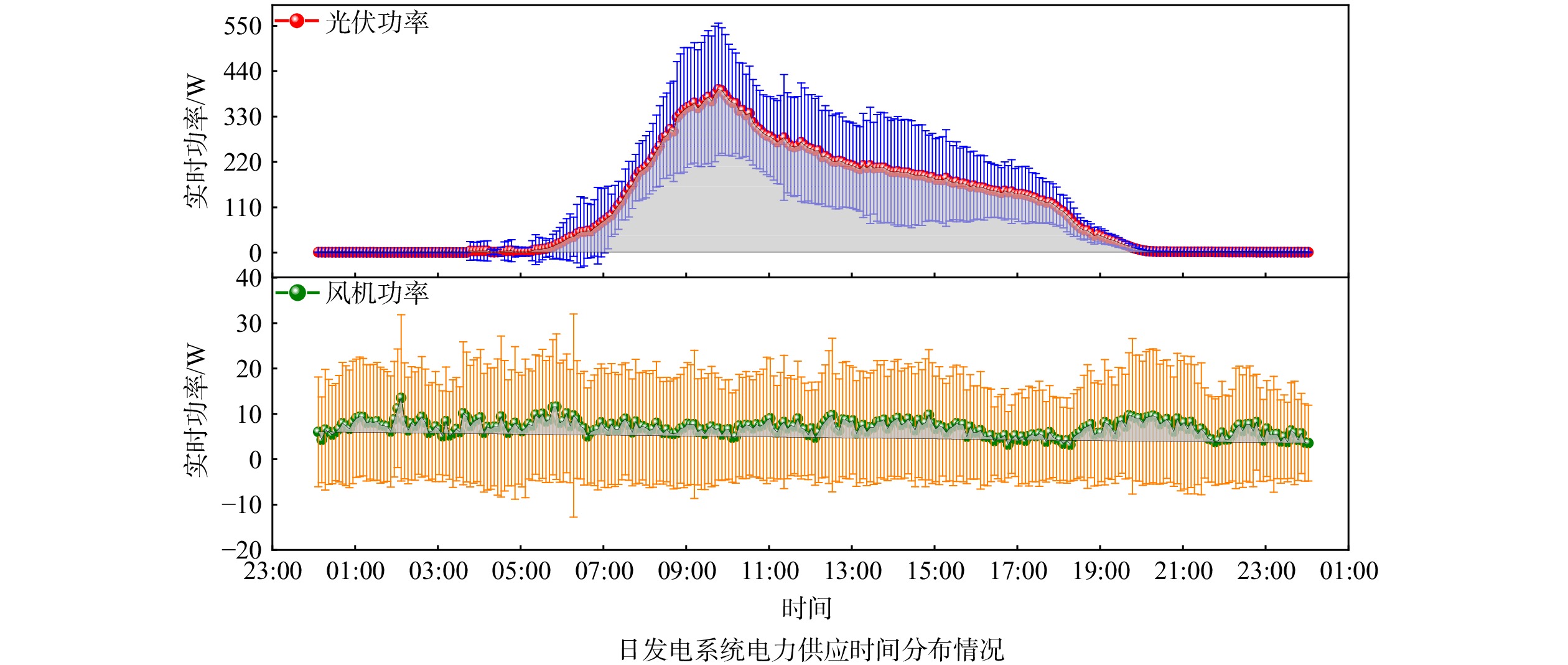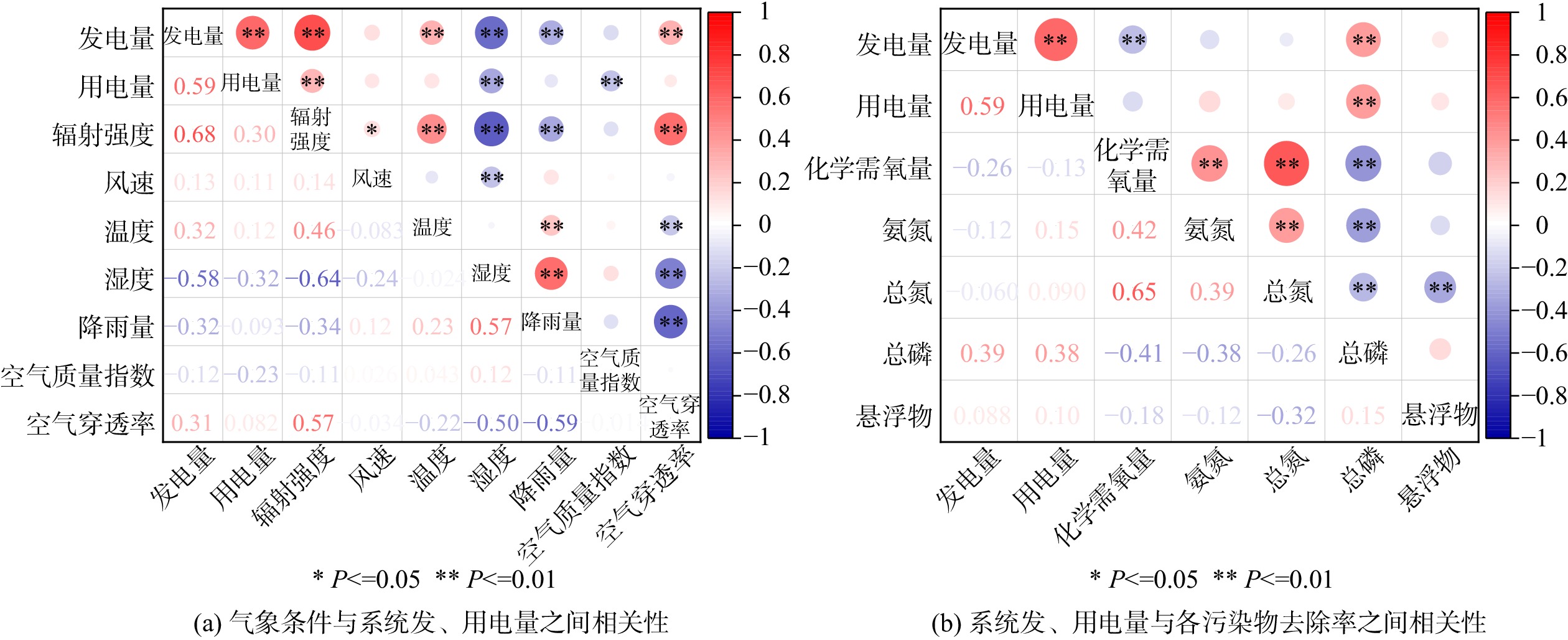-
近年来,随着乡村振兴战略的实施和社会经济的加速发展,农村地区的污水排放量和污染物成分复杂度也在逐年提高[1-2],污水中各类污染物的排放标准越来越严格,水资源污染状况也变得尤为突出[3]。目前,农村污水中的水质水量变化系数大,且处理技术过程相对复杂[4],导致农村地区的水资源污染状况不断加剧[5],传统的农村污水处理设施存在着运行能耗高、难以长效运行[6]、后期投入经费大、出水水质不稳定等问题[7]。加之农村污水传统处理工艺运维难[8],运行过程相对复杂,其中生物处理技术由于其自身运行能耗高[9],而且北方极端低温条件导致微生物活性降低,使得设施处理效果较差,最终导致农村污水处理设施运行不稳定或出现处理设备“晒太阳”等现状[10-11]。
基于村镇地区技术人员少、运维力量相对薄弱等客观条件[12],本系统采用风-光互补发电驱动,通过可编程逻辑控制器(programmable logic controller, PLC)以实现基于无人值守、少维护为核心特点的低能耗高效污水处理,生物和物理处理技术的耦合,实现两者的协同作用去除污水中污染物,针对冬季低温的环境中微生物活性较弱处理效果不佳的情况,本系统可以最大限度的利用物理处理工艺的作用,有效改善北方村镇普遍存在的污水处理设施冬季运行效果差的问题。本研究通过对太阳能和风能的变化规律及对应不同气象条件下发电量、用电量效能进行分析,对生物物理耦合处理系统污染物去除效果的研究,在一定程度上对推动风-光互补驱动农村生活污水处理的规模化应用提供指导意见。
-
1) 发电系统。风-光互补发电系统由太阳能电池板 (英利 YL330CELL×5,330W33V9A,中国) 、光伏控制器 (光合硅能 MPPT 通用型 40A 12V24V36V48V 自适用 40A,中国)、风力发电机 (NE-400R,400 W 24V400W,中国)、风力充电控制器 (NE-300400 24V400W,中国)、逆变器 (方超 2500-E-24 24V2500W)、蓄电池 (圣阳电源 GFM-200C×12 2V200Ah (C10,1.8V/只) ,中国)、接触器 (施耐德 LC1-D40,法国) 等组成。太阳能电池板的面积为 10.0 m2 ;风机采用垂直轴风力发电机,风轮叶片直径 0.8 m。风力发电和光伏发电分别通过风机和光伏控制器给蓄电池充电,由于受到气候条件的限制,发电规律与负载的用电要求并不一致,因此需要配备储能装置。最后通过逆变器将蓄电池储存的直流电转换为负载所需的交流电,来满足负载用电的需要。
2) 实验装置。本实验装置如图1所示,由风-光互补发电单元 (图1(a)) 、自控及储能单元 (图1(b)) 、生物物理耦合反应器 (图1(c)) 组成。生物物理耦合反应器的总有效容积1 100 L,工艺选择采用两级A/O+物理过滤+紫外灭菌的污水处理系统。基于西北地区自身优势,风能、太阳能资源丰富,利用风-光互补发电为装置供电。本装置的设计处理水量为2.0 m³·d−1,厌氧池、好氧池、缺氧池、好氧池按1∶2∶1.5∶2.5的比例设计。系统运行时,进水由污水泵从原水池供给,原水首先进入调节池,经生物段处理后,流入物理段过滤吸附。
3) 运行方式。实验于2022年4月底开始启动,连续运行202 d。厌氧池、一级好氧池、缺氧池、二级好氧池、一级过滤池和二级过滤池溶解氧浓度分别为(0.02±0.12)、(2.68±1.15)、(0.11±0.44)、(2.93±1.36)、(0.31±0.15)和(0.03±0.07) mg·L−1,水力停留时间为14 h,保证设备24 h连续运行。装置启动期间每隔1 d进行1次进出水水质检测,每隔5 d进行1次各个反应区水质检测。直到COD去除率和NH4+-N去除率稳定达到80%以上,且可用肉眼观察到生物膜厚度约有1 mm左右或者生物膜上镜检观察到变形虫、轮虫和线虫等微生物,即表明启动挂膜成功[13]。
实验设备位于内蒙古自治区土默特左旗察素齐镇某村,污水来自日常生活化粪池污水 (包括灰水和黑水) ,属于低碳氮比污水 (简记为C/N,指COD/TN) ,C/N在3.06左右。具体水质情况和理化情况见表1所示。
-
本研究结合生活污水污染物特征主要对污水中的COD、NH4+-N、TN、TP、SS、pH等进行检测。COD 采用快速消解分光光度法(HJ/T 399-2007)测定,NH4+-N 采用纳氏试剂分光光度法(HJ 535-2009)测定,TN 采用碱性过硫酸钾消解紫外分光光度法 (HJ 636-2012) 测定,TP 采用钼酸铵分光光度法(GB/T 11893-1989)测定,SS 采用重量法(GB/T 11901-89),pH 采用 (MIK-PH(ORP)6.0-CN7,美控,中国) 测定,DO采用 (MIK-DY2016-CN2,美控,中国) 测定。
实验中太阳能辐射强度采用太阳能辐射测量仪 (华控兴业 HSTL-FSDJY) 检测并记录,风速采用风速测定仪 (华控兴业HSTL-FS01) 检测并记录,太阳能和风力实时发电强度、太阳能和风能发电量、反应器各工况的运行时长等,均通过相应的电子传感器与PLC (FX2N-40M,天津佳创科技发展有限公司,中国) 检测并记录,能耗由电量表实时记录。
-
全生命周期成本(life cycle cost, LCC)是一个建筑物或建筑物系统在一段时期内的拥有、运行、维护和拆除的总折现后的货币成本[14-15],被广泛应用于污水处理领域中,国际标准ISO14040将LCC定义为系统在整个生命周期内 (包括建设、运行与报废处理) 的输入、输出和潜在环境影响的汇编与评价[16],并且随着污水处理领域从单一的污染物去除目标已逐步向低能耗,甚至能源回收方向发展[17]。通过对比不同运行模式下全生命周期成本,确定本研究采用的供能模式,可最大程度节约投资成本。全生命周期成本=建设成本+运行成本-净残值,其数学模型表示如式(1)、式(2)所示。
式中:Ck为各项建设成本或初始化成本;Ch为后期投资(各设备更新成本);Ci为各年运行成本或未来运行成本;t0为污水设备更新时的时间变量;f为通货膨胀率,参考CPI指数;r为折现率;S为净残值;T为全生命周期;t为运行成本计算的时间变量。
-
本实验装置所在地,内蒙古自治区土默特左旗察素齐镇某村 (经度111.182 333°,纬度40.700 645°) ,供能方式采用风-光互补发电蓄电池供能的方式,发电效果一定程度上会受到环境条件的影响。太阳能发电主要受到太阳辐照度和环境温度的影响[18]。风能的随机性较强,受风速及风向的影响较大[19]。风力发电作为太阳能发电的补充,可提高供电的稳定性,增强系统对不同气象条件的适应性。除此之外,降雨量、湿度、空气质量以及空气穿透率等也可能直接或间接影响发电效率。因此,调研并分析了该地2020年1月1日至2021年12月31日两年不同季节下的风速、太阳能辐射强度、湿度、降水量、空气质量指数和空气穿透率数据,数据来源于美国NASA数据官网。具体如下图2所示。
试验区所在地气候属于典型的温带大陆性气候,主要气候特征是冬季严寒漫长、春季风大少雨,夏季温热短促,秋季气温剧降;昼夜温差大,日照时间充足,无霜期短。由图2分析结果显示,试验地环境温度和太阳能辐射强度的年际变化均呈现抛物线型,周期性、季节性规律极为显著;其中湿度表现为春、夏季较低,在秋、冬季较高;降水量的多少与气温高低基本相同,形成在气温较高的月份降水最多,气温较低的月份降水最少,因此降雨主要集中在夏季,春秋两季分布均匀,冬季最少;空气穿透率的年际变化规律不明显,且由于易受周围环境影响,春、夏、秋、冬的波动均比较明显,尤其夏秋季节;空气质量指数在春季和冬季较差,夏季和秋季空气质量优于其他2个季节。
对于太阳能辐射强度,由于试验地区主要以晴好天气为主,能见度高,空中云层遮挡较少的原因,辐射强度随四季变化呈现先升高后降低的趋势,夏季日照时间较春季更长,为13 h左右,太阳能辐射强度最大日均值为165.86 W·m−2左右。春、秋季,太阳能辐射强度变化曲线较为相似,但随时间变化更为剧烈,持续时间更短。冬季太阳能辐射强度峰值为全年最低,均值为50 W·m−2左右,且持续时间较其他季节最短,冬季日照时长为9 h左右。由图可知,春、夏、秋、冬四个季节的太阳能辐照度变化范围分别为(92.63±37.22)、(125.20±25.31)、(86.07±32.08)和(47.89±32.31) W·m−2。就平均风速而言,春、夏、秋、冬4个季节的变化范围分别为(5.59±2.14)、(5.22±2.14)、(4.45±1.50)和(3.71±1.94) m·s−1。因此,平均风速在年际变化上无明显规律,春、夏2季平均风速略大于秋、冬季节,特别是在春夏更替时,平均风速基本能达到5 m·s−1以上。
综上来看,将风能和太阳能相互结合发电,可以在太阳能较为短缺的冬季以及某些太阳辐射强度较弱的天气情况下,有一定的补充作用,相比单一光伏发电模式整体效能更加稳定。
-
在实验期间,对反应器运行稳定后光伏发电板和风力发电机的发电量、负载用电量以及相对应的能源利用率进行了为期202 d的时间序列实验连续监测,结果如图3所示。
由图3可以看出,运行期间,日均发电量变化范围为(2.78±0.39) kW·h,日均用电量变化范围为 (2.52±0.27) kW·h,能源利用率 (用电量/发电量) 变化范围为91.49%±10.03%。太阳能发电量的变化范围为(2.57±0.34) kW·h,风力发电量的变化范围为(0.21±0.14) kW·h。太阳能、风能占总发电量的总体比重分别为92.32%±4.56%、7.68%±4.56%,因此可以看出系统主要以太阳能发电为主,风机发电为补充,有效地提高了供电系统的稳定性。
图4是风-光互补发电系统中光伏发电功率、风机发电功率随时间变化曲线,以系统运行202 d为监测周期。由图4分析可知,风-光互补发电系统中光伏功率随时间变化曲线呈现出先升高后降低的趋势,然而风机功率随时间变化曲线则呈现无规则变化,主要原因是来自其风速本就不稳定所致,因此风力发电的随机性较强,供电稳定性和强度较弱。对图4两曲线分别进行数学积分统计,图中阴影总面积即当日风-光互补发电系统在自控系统干预之下的电力输出。由此可以得出风-光互补发电系统在一天期间光伏发电系统输出电力均值为2 620 W·h;风机发电系统输出电力均值为166 W·h,总发电量累计输出电力均值为2 786 W·h,其中太阳能、风能占总发电量的总体比重分别为94.04%、5.96%,和图3分析结论基本符合。因此,风-光互补发电模式保证了发电系统稳定的电力输出。
-
对污水处理反应器进行了202 d的数据监测,期间重点考察了系统对COD、NH4+-N、TN、TP、SS的去除效果。系统各单元水质检测浓度均值情况见表2,系统对各污染物去除效果结果见图5所示。
如表2和图5所示,系统对于COD、NH4+-N、TN、TP、SS去除率分别为86.73%±2.89%、87.82%±6.59%、75.63%±11.79%、78.65%±6.39%、94.59%±0.89%,其中COD、NH4+-N、TN、TP、SS进水浓度均值分别为(211.61±47.00)、(57.81±12.17)、(63.22±7.95)、(4.91±0.94)、(127.31±36.79) mg·L−1;出水浓度均值分别为(28.60±15.5)、(7.04±6.97)、(15.30±11.25)、(1.04±0.30)、(6.38±0.04) mg·L−1。由图5可以看出,进水中COD、NH4+-N和TN、TP、SS浓度有较大幅度的波动,但系统出水水质仍保持稳定,说明本系统具有较强的抗冲击负荷能力[20]。此外,系统中的COD主要在生物段被反应去除,厌氧池中因溶解氧和硝态氢结合氧的消耗而呈厌氧状态,易生物降解COD被聚磷菌[21]和反硝化细菌等异养型微生物代谢活动去除[22]。好氧池中的微生物在适宜的温度、溶解氧及曝气条件下,通过吸附、氧化并分解水中的大部分有机物,并将进水中的大部分NH4+-N转化为NO3-N[23]。生物物理耦合处理系统对COD、NH4+-N和TN的去除效率均表现出随着运行历时而增加且稳定的趋势,这与系统采用两段缺氧和好氧,耦合物理过滤吸附模块有关,集生物法和物理法的优点,起到高效去除污染物作用的同时保证了在不同水力负荷下仍可稳定运行。对于系统脱氮效率较低的原因主要是进水碳源不足、碳氮比偏低[24],以及系统内部缺氧好氧交替不够充分也影响反硝化效果[25]。系统对TP的去除效率不具有相同的规律,物理段投加了高效的除磷滤料虽可以实现污水中TP的达标,但是通过对TP的去除监测发现,去除率具有降低的趋势,这是由于生物法除磷较为稳定,但是物理除磷中滤料对于污水中磷酸盐吸附量达到一个饱和值后会随着时间的增加[26],其对TP的去除率表现为先迅速升高并趋于稳定,随后表现出略微下降的趋势。因此对TP的去除具有一定的影响。同时由表2可得,系统中生物段对于COD、NH4+-N、TN、TP和SS的去除贡献率 (去除量/总体去除量) 分别为88.52%、90.48%、89.77%、51.28%、92.15%;物理段对于COD、NH4+-N、TN、TP和SS的去除贡献率 (去除量/总体去除量) 分别为11.48%、9.52%、10.23%、48.72%、7.85%。由此可见,各污染物的去除主要依靠生物段的作用进行去除,物理段主要实现对于TP的辅助去除。综上,系统出水水质中COD、NH4+-N、TN、TP和SS均可满足《内蒙古自治区农村生活污水处理设施污染物排放标准 (试行) 》(DBHJ/001-2020)一级标准。
-
通过皮尔曼(Spearman)相关性矩阵分别探究了气象条件对系统发电量的影响和系统发电量对系统运行处理效果的影响。图6(a)表征了气象条件和系统发电量、用电量的相关性。分析结果显示,发电量与用电量、辐射强度、风速、温度、湿度、降雨量、空气质量指数、空气穿透率相关系数分别为0.59、0.68、0.13、0.32、−0.58、−0.32、0.12、0.31。发电量与辐射强度、温度、空气穿透率相关性显著 (P<0.05) ;与湿度、降水量呈显著负相关 (P<0.05) 。本系统中设计的风力发电量约占总发电量的10%左右,大部分电量来源于光伏发电,太阳辐射强度是决定光电转化效率及光伏系统效率的重要因素之一,其直接关系到整个系统的平均功率输出[27]。同时,有前面的结论,辐射强度和温度随四季变化的曲线趋势相似,呈先升高后降低的趋势,两者之间的吻合度较高,表现出温度越高,辐射强度也是较高。空气穿透率是指光线通过大气层时所受到的阻碍程度,空气穿透率越高,光线在通过大气层时受到的阻碍越小,光照强度越高发电的效率就越高[28]。然而湿度和降雨主要是通过影响光照强度来体现。在降雨天气中,云层密集,光照强度会减弱,从而降低光伏发电的效率。雨水可能会在光伏板表面形成水膜,降低光的透过率,进一步降低光伏发电的效率。湿度主要是通过水蒸气含量对光的吸收和散射来体现。湿度越高,大气中的水蒸气含量越大,可能会增加光的散射和吸收,降低光伏发电的效率。
图6(b)表征了系统发电量、用电量与各污染物去除率之间相关性。分析结果显示,发电量与用电量、COD、NH4+-N、TN、TP、SS去除率相关性较弱,但是通过分析可以看出COD、NH4+-N、TN之间的去除相关性显著。分析原因,当污水处理系统的有机物去除效果较好时,NH4+-N和TN的去除效果也会相应较好。这是因为有机物的降解过程会产生一些有机氮化合物,而污水处理系统中的一些工艺 (如生物脱氮) 可以将这些有机氮化合物转化为NH4+-N,并进一步去除。
综上所述,气象条件显著影响系统的发电效果,发电量进一步影响系统对于各污染物的处理效果,但影响不显著。
-
本研究采用LCC分析此污水处理设备中常规市电供能 (模式-I) 、风-光互补蓄电池供能 (模式-II) 2种模式的建设、安装、运行、设备更新及报废成本。按照光伏发电板和风力发电机的工作时长将评价体系的生命周期设计为25年。通过对比全生命周期成本确定本研究采用的供能模式可最大程度节约投资成本。
下表列出了2种模式的建设和投资清单。净残值S取固定资产原值的4%计算,根据央行数据得知,2016—2021年期间CPI的平均值为2%,贷款利率i=4.75% (2021年) ,则计算出r=6.845%,根据其公式进行计算,计算结果见表3。
由表3可以看出,根据全生命周期成本评价,本系统25年内建设成本和运维成本的总和为21 040元,而常规市电供能的运行模式下建设成本和运维成本总和为27 185元,风-光互补蓄电池供能模式系统基建投资总成本相对于常规市电供能模式降低了22.60%,因此相比于常规市电供能运行的模式,该系统模式成本较低、经济性较好。
-
1) 采用风-光互补蓄电池供能驱动污水处理模式,202 d的连续运行实验结果显示,系统对COD、 NH4+-N、TN、TP和SS的去除率分别为86.73%±2.89%、87.82%±6.59%、75.63%±11.79%、78.65%±6.39%、94.59%±0.89%,出水水质满足《内蒙古自治区农村生活污水处理设施污染物排放标准 (试行) 》(DBHJ/001-2020)一级标准。
2) 通过对风-光互补发电系统的效能分析,证明风能对于太阳能发电的补充有效地提高了供电系统的稳定性,实现发电系统电能输出稳定,且能源利用率达到90%以上。
3) 通过皮尔曼(Spearman)相关性矩阵分析发现,气象条件显著影响系统的发电效果,系统发电效果进一步影响系统对于各污染物处理效果,但影响不显著。
4) 风-光互补蓄电池供能模式系统基建投资总成本相对于常规市电供能模式降低了22.60%,在环境友好性和可持续性的发展具有重要意义。
风-光互补驱动农村污水生物-物理耦合多级处理系统开发
Wind-solar complementation drives the development of bio-physical coupling multi-stage treatment system for rural sewage
-
摘要: 目前,清洁能源应用于污水处理领域最大的挑战是易受天气状况影响导致电能无法稳定输出,负载无法连续正常工作。因此,为保证电能的稳定输出和设施正常运行,采用风-光互补蓄电池供能模式,通过对不同季节太阳能和风能强度变化监测与分析,确定太阳能与风能具有季节互补性。在此基础上,设计了风-光互补驱动农村污水生物-物理耦合多级处理设施的集成系统,采用生物和物理技术的耦合实现高效稳定去除污水中的污染物。202 d连续运行实验结果表明:通过系统的效能分析,证明风能对于太阳能发电的补充,有效地提高了供电系统的稳定性,实现发电系统电能输出稳定,且能源利用率可达90%以上;系统对污水中COD、NH4+-N、TN、TP和SS的去除率分别为86.73%±2.89%、87.82%±6.59%、75.63%±11.79%、78.65%±6.39%、94.59%±0.89%;出水满足《内蒙古自治区农村生活污水处理设施污染物排放标准 (试行) 》 (DBHJ/001-2020) 一级标准。研究结果证明利用风-光能互补驱动生物物理耦合处理农村生活污水可行。Abstract: At present, the biggest challenge in the application of clean energy in the field of sewage treatment is that it is susceptible to weather conditions, resulting in unstable output of electric energy and continuous normal operation of the load. Therefore, in order to ensure the stable output of electric energy and the normal operation of facilities, the wind-solar hybrid battery energy supply mode was adopted, and the seasonal complementarity of solar and wind energy was determined by monitoring and analyzing the changes of solar and wind energy intensity in different seasons. On this basis, an integrated system of wind-solar complementary driving bio-physical coupling multi-stage treatment facilities for rural sewage was designed, and the coupling of biological and physical technology was used to achieve efficient and stable removal of pollutants in sewage. The results of 202 days of continuous operation showed that through the efficiency analysis of the system, it was proved that wind energy can supplement solar power generation, effectively improve the stability of the power supply system, realize the stable power output of the power generation system, and the energy utilization rate can reach more than 90%. The removal rates of COD, NH4 +-N, TN, TP and SS in sewage were 86.73%±2.89%, 87.82%±6.59%, 75.63%±11.79%, 78.65%±6.39%, 94.59%±0.89%, respectively. The effluent met the first-level standard of the Inner Mongolia Autonomous Region Pollutant Discharge Standard for Rural Domestic Sewage Treatment Facilities (Trial) (DBHJ/001-2020). The results proved that it was feasible to use wind-solar energy complementarity to drive biophysical coupling to treat rural domestic sewage.
-

-
表 1 系统进水水质
Table 1. System influent water quality
序号 参数 浓度范围/
(mg·L−1)均值±标准差/
(mg·L−1)1 COD 108.00~453.00 211.61±47.00 2 NH4+-N 40.18~104.80 57.81±12.17 3 TN 54.40~108.90 63.22±7.95 4 TP 3.10~7.30 4.91±0.94 5 SS 72.14~243.10 127.31±36.79 6 pH 7.08~8.24 7.75±0.22 表 2 系统各反应单元水质浓度均值情况表
Table 2. Mean water concentration of each reaction unit of the system
项目名称 COD/(mg·L−1) NH4+-N/(mg·L−1) TN/(mg·L−1) TP/(mg·L−1) SS/(mg·L−1) 进水 211 57.81 63.2 4.9 127.31 A1 176 46.32 52.6 4.4 71.30 O1 130 33.85 39.7 3.8 46.31 A2 98 26.05 32.8 3.5 24.79 O2 49 11.87 20.2 2.9 16.29 一级过滤池 40 10.05 17.8 1.6 9.14 二级过滤池 (出水) 28 7.04 15.3 1.0 6.83 表 3 2种模式全生命周期成本核算表
Table 3. Life cycle costing table of the two modes
核算阶段 核算项目 模式1 /元 模式2 /元 建设阶段 初始化成本 7 350 14 800 后期投资 未来运行折现值 16 473 0 运行阶段 设备更新折现成本 3 808 7 117 拆除阶段 净残值 446 877 全生命周期成本 27 185 21 040 -
[1] 丁建军, 杨云波. 农村生活污水治理现状及技术应用比较研究[J]. 资源节约与环保, 2022(8): 141-144. [2] 张永平, 李妮, 温静静, 等. 光伏驱动一体化装置处理农村生活污水的性能研究[J]. 山东农业大学学报(自然科学版), 2022, 53(4): 599-604. [3] 肖炘圻, 陈鑫, 周伟, 等. 竖流式一体化反应器处理乡镇污水的影响因素[J]. 水处理技术, 2019, 45(8): 116-119+124. [4] 谢文玉, 李德豪, 钟华文, 等. 一体化A/O生物膜反应器脱氮特性研究[J]. 环境工程学报, 2011, 5(3): 570-574. [5] HAN C, LIU J, LIANG H, et al. An innovative integrated system utilizing solar energy as power for the treatment of decentralized wastewater[J]. Journal of Environmental Sciences, 2013, 25(2): 274-279. doi: 10.1016/S1001-0742(12)60034-5 [6] 梁和国, 高绣纺. 中国太阳能微动力净化槽技术研究初探[J]. 环境工程, 2015, 33(7): 24-26+80. [7] 蔡铭杰, 马宏瑞, 刘俊新, 等. 太阳能驱动分散型污水处理系统及其自动化控制研究[J]. 山西大学学报(自然科学版), 2013, 36(1): 118-123. [8] 李鹏宇, 刘俊新, 郑天龙, 等. 无蓄电池风-光能互补驱动生物反应器处理农村生活污水的可行性[J]. 环境工程学报, 2018, 12(9): 2429-2436. [9] 黄田, 郑淋峰, 罗彬, 等. 高寒高海拔地区农村生活污水治理模式探讨[J]. 资源节约与环保, 2023(3): 89-93. [10] 颜鲁薪, 甄箫斐, 雒苗, 等. 基于太阳能光伏光热的污水处理系统[J]. 中国沼气, 2023, 41(2): 65-75. [11] SONI A, STAGNER J A, TING D S K. Adaptable wind/solar powered hybrid system for household wastewater treatment[J]. Sustainable Energy Technologies and Assessments, 2017, 24: 8-18. doi: 10.1016/j.seta.2017.02.015 [12] HAN Y, MA J, XIAO B, et al. New Integrated Self-Refluxing Rotating Biological Contactor for rural sewage treatment[J]. Journal of Cleaner Production, 2019, 217: 324-334. doi: 10.1016/j.jclepro.2019.01.276 [13] 孙广垠. 改性组合填料生物接触氧化强化去除微污染河水氮磷效能及机理研究[D]. 中国矿业大学, 2021. [14] 黄辉, 张勤, 傅斌. 基于全生命周期成本理论的污水厂投资方案比较[J]. 中国给水排水, 2013, 29(1): 101-104. [15] 何津津. 基于生命周期评价的光伏发电碳排放研究[D]. 南京航空航天大学, 2017. [16] COROMINAS L, FOLEY J, GUEST J S, et al. Life cycle assessment applied to wastewater treatment: state of the art[J]. Water Research, 2013, 47(15): 5480-5492. doi: 10.1016/j.watres.2013.06.049 [17] ROEFS I, MEULMAN B, VREEBURG J H G, et al. Centralised, decentralised or hybrid sanitation systems Economic evaluation under urban development uncertainty and phased expansion[J]. Water Research, 2017, 109: 274-286. doi: 10.1016/j.watres.2016.11.051 [18] 李立雄, 阳同光, 袁越阳, 等. 基于改进有限集模型预测控制策略的光伏发电系统最大功率点追踪算法[J]. 电力系统保护与控制, 2021, 49(17): 28-37. [19] 邢月. 风电机组运行状态监测与健康维护关键技术研究[D]. 华北电力大学(北京), 2021. [20] LI P, ZHENG T, LI L, et al. An appropriate technique for treating rural wastewater by a flow step feed system driven by wind-solar hybrid power[J]. Environ Research, 2020, 187: 109651. doi: 10.1016/j.envres.2020.109651 [21] DU R, CAO S, LI B, et al. Performance and microbial community analysis of a novel DEAMOX based on partial-denitrification and anammox treating ammonia and nitrate wastewaters[J]. Water Research, 2017, 108: 46-56. doi: 10.1016/j.watres.2016.10.051 [22] 高小波. 改良型多级A/O工艺处理低碳源生活污水实验研究[D]. 兰州交通大学, 2016. [23] 陈祥瑞, 杜强强, 韩文杰, 等. 基于纯膜MBBR的紧凑型污水处理BFM中试基质转化特性[J]. 环境工程学报, 2021, 15(11): 3741-3756. [24] 崔鹏. A/O生物接触氧化—垂直流人工湿地组合工艺处理生活污水试验研究[D]. 兰州交通大学, 2017. [25] 罗锋, 盛德洋, 张忠祥, 等. 生物接触氧化法去除微污染水中氨氮的中试研究[J]. 中国给水排水, 2022, 38(20): 109-115. [26] VIDAL B, HEDSTROM A, HERRMANN I, et al. Phosphorus reduction in filters for on-site wastewater treatment[J]. Journal of Water Process Engineering, 2018, 22: 210-217. doi: 10.1016/j.jwpe.2018.02.005 [27] 陈晓东, 张福祥. 现阶段光伏发电系统中发电量影响因素研究[J]. 中国高新科技, 2022(24): 16-19. [28] 魏晨晨, 王超, 李想, 等. 光伏组件发电效率影响因素分析[J]. 建设科技, 2023(1): 79-81. -




 下载:
下载:






